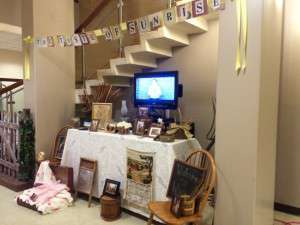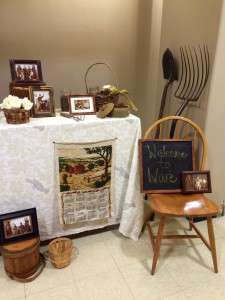by Haley Flanders, dramaturg

We are excited for you to come and see The Taste of Sunrise in the Margetts Black Box Theatre in the BYU Harris Fine Arts Center! The show opens TONIGHT (Friday March 11) and we are selling out, so get yours tickets as soon as possible! This show is amazing!

When you come to see the play, I invite you to visit the lobby display in front of the theatre entrance. As the dramaturg, I create a display that welcomes you to the show and envelopes you in the world of the play, even before entering the performance space. Creating and assembling the lobby display is one of my favorite jobs as a dramaturg. I have put together some essential props and pictures, along with a very special video featuring local members of the Deaf and Hard of Hearing community. They volunteered to sign their stories and messages of inspiration. The lobby display will also have texts and pictures of the people on the back wall so that audience members who do not sign can read what is being signed in the video. I love having the text separate from the video so that students and professors who walk down this hall can read the text and be motivated to see the play and become more invested in our Deaf community in Provo.

Here is the lobby display table:

I designed it to be an extension of the set, and to showcase some of the wonderful publicity photos. Also, this play is a memory play, which means it takes place in the mind and memory of the main character, Tuc.It takes place in 1917-1928 and showcases the most important moments in Tuc’s younger years. Since it is a memory play, I wanted the lobby display to look like the inside of Tuc’s memory. So I selected pieces that Tuc values from his childhood. The suitcases, jars, water buckets, and baskets are meant to personify how memory stores our most precious moments within us so we can carry them with us throughout our lives. They often make us who we are.

All of the photographs on the table are production photos, except for two: the map of Illinois, which resembles the setting of the play (Ware is in Union County in the bottom left of the state) and a painting of the Mississippi River taken from Dug Hill, which is where Nell Hicks lives, isolating herself from the town below.

The most important element to Tuc’s sense of home is dirt. Growing up on a farm in Ware, Illinois in the early twentieth century, and then traveling to the big city in St. Louis, Missouri for school, dirt resembles home and family to Tuc, especially his close relationship with his father, Jonas.
Right before Tuc is sent off to school, Jonas takes dirt from the ground (found in small troughs on the edges of the set) and places them in a little bag for Tuc and says to him, “This is your land, son. It’s where you are from. It’s where you’ll come back to [. . .] Home, always here.” So the lobby display is filled with jars of dirt to resemble the piece of home Tuc carries in his pocket throughout the play to remind him of home and his father. Tuc also collects jars of honey from beehives with his father.

The lightbulb resembles the sunrise in the play’s title, and how memories bring a sense of light and truth to Tuc’s journey toward self discovery and identity.

The ceramic container on the right corner of the table resembles Nell Hicks, the medicine woman and midwife. She takes care of animals and people, and tries to heal them throughout the play. However, many people believe she is a witch that causes harm instead of health. She is actually a very caring person, a gifted nurse, and a mother figure to Tuc and others. In the story, she references some natural herbs that she uses for healing, such as purple sage, shepherd’s purse, ox blood soup, and chamomile blossoms. Thus the white flowers in the basket and jar on the table represent these blossoms used to induce sleep.

The farming tools on and beside the table represent the setting and the hardworking farmers like Tuc’s father. Tuc also works with his hands as a car repairman.
Hanging over the edge of the table, the calendar personifies that this a memory play, spanning 11 years and combining different moments and memories over time.

On the ground, there is a suitcase with a baby blanket and baby clothes for a girl, along with a 1910’s picture of the Central Institute for the Deaf in St. Louis, Missouri. The suitcase resembles the one Tuc takes with him when he leaves for school – his first time ever leaving home. The clothes and blanket resemble certain characters either in, or referenced in, the play (NO SPOILERS!) Baby clothes are even used in Mother Hicks, the first play in this trilogy.

The movie poster of The Sheik starring Rudolph Valentino is a reference to the character Maizie, who loves Valentino, mourns his death, and acts out portions of the movie in costume during the play. Since the school will not allow the children to leave school in order to see the movie (in honor of Valentino’s recent death), the children decide to act it out, since they have already seen it many times!

The blackboard sign with “Welcome to Ware” written in chalk resembles the chalkboard that is used by Dr. Alexis Graham during the school scene at the Central Institute for the Deaf. She tries to teach Tuc and the other students how to speak different vowels and plosives by writing the letters and words on the chalkboard and speaking them for the students.

As you may have noticed, the lobby display is also filled with water buckets, birds, and plants that look like grain or hay. These all hold specific meaning. The first three words in the play (signed by Tuc) are “wind”, “water”, and “bird”. These are the three main sounds he remembers hearing when he was young, before he became Deaf due to a terrible fever. The bird feeder and the table cloth featuring birds resemble the birds he used to hear. The water buckets and the washboard resemble the water. The plants resemble the fields of rural Ware, Illinois. I can just picture baby Tuc hearing the wind rushing through the blades. These three words are also mentioned near the very end of the play, as Tuc teaches others to sign so they can communicate with him.

Well, there you have it! I hope that you enjoy observing these various pieces of the lobby display, and that stepping into the mind and memory of Tuc is a moving and enjoyable experience for you as an audience member. As you watch and listen to the messages being shared, and the signing being performed, remember, as Nell says in the last line of the play, “Some things are so beautiful, they don’t need sound.”

